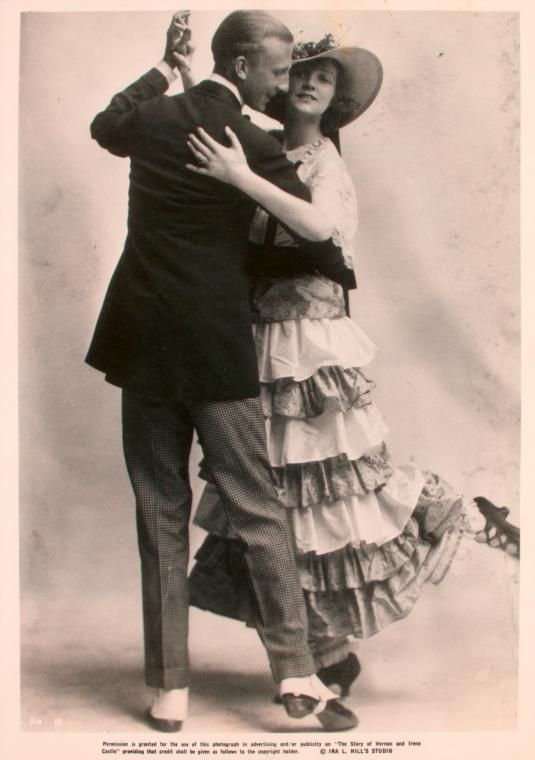The last of the interviewees in this week's lineup of Carson on TCM is Fred Astaire, in an interview from 1973. TCM will then be spending the rest of the evening with films that Astaire made in the 1930s with Ginger Rogers, the two being such a famous screen team. The night ends with what was their last movie for ten years, The Story of Vernon and Irene Castle, at 5:00 AM Tuesday.
 The movie is a biopic about the Castles, with Astaire playing Vernon and Rogers playing Irene. (The real-life Castles, not Astaire and Rogers, are pictured at left.) Vernon was a British-born comic who by 1910 was working as a second-rate vaudeville comic doing the tourig thing. His travels take him not to the big cities, but to smaller places like New Rochelle, NY, which is where he meets Irene, the daughter of a middle-class doctor. Things click between them, and eventually Vernon winds up back at Irene and her familiy's house, which is where she shows off her talent, which is a raw, untrained dance number. Vernon sees that Irene's got talent, and since the two love each other, they wind up getting married and trying to make it in the clubs as a couple doing their dance routine.
The movie is a biopic about the Castles, with Astaire playing Vernon and Rogers playing Irene. (The real-life Castles, not Astaire and Rogers, are pictured at left.) Vernon was a British-born comic who by 1910 was working as a second-rate vaudeville comic doing the tourig thing. His travels take him not to the big cities, but to smaller places like New Rochelle, NY, which is where he meets Irene, the daughter of a middle-class doctor. Things click between them, and eventually Vernon winds up back at Irene and her familiy's house, which is where she shows off her talent, which is a raw, untrained dance number. Vernon sees that Irene's got talent, and since the two love each other, they wind up getting married and trying to make it in the clubs as a couple doing their dance routine.
This eventually takes them to Paris, where they believe they've got a gig lined up at one of the famous nightclubs, although they're wrong; the manager wanted to see Vernon's comedy number. However, English agent Maggie Sutton (Edna Mae Oliver) is able to get them a chance at another of the nightclubs. This chance proves successful, as their dance, the Castle Walk, takes Paris by storm, with the Castles in demand everywhere, and women wanting to look just like Irene. (In real life, Irene Castle was a famous brunette and had her hair famously short; in the movie, Ginger Rogers keeps her blonde hair and keeps it long, which is one of the big departures from real life.) The two continue their fame and career together until 1914, which, if you know your history, you'll know is when World War I began.
I mentioned at the beginning that Vernon was British-born, so once World War I came he decided to support the British war effort, doing so by becoming a distinguished pilot. If William Wellman had directed a movie like this, he could have told you that World War I air action was dangerous, but amazingly Vernon Castle survived all of the dogfights, even winning a Croix de Guerre along the way. He was sent back to North America to become a flight instructor for the Americans, who had recently entered the war. Ironically, being out of the theater of action ended up being less safe, as Vernon was killed in a training accident. (I don't think I'm giving too much away, since this is a biopic.)
I'm generally not a big fan of musicals. The Story of Vernon and Irene Castle is different, though, because it's not so much a musical as it is a biopic about people who danced. As such, the dance numbers fit well into a realistic plot; one of the problems with other Astaire/Rogers movies is that the plots seem contrived at best, serving as a hook upon which to hang the dance numbers. Astaire and Rogers are both quite good; Oliver is enjoyable; and Lew Fields, who in real life was the star of the vaudeville review that led to Vernon's meeting Irene. Walter Brennan plays the Castles' servant, which is another departure from real life, as the Castles has a black servant. Irene Castle was a technical advisor for the film, and apparently didn't like some of the difference Hollywood made, such as the casting of Brennan or Rogers' keeping her natural hair. But for those of us today who don't know every little detail about the Castles, this isn't such a big deal. The main facts all seem to be more or less correct, and the ending scene is inentive.
TCM lists The Story of Vernon and Irene Castle as being part of an Astaire/Rogers DVD box set. I'm not certain if it's available individually.
Noirsville Clip of the Week
4 hours ago

No comments:
Post a Comment